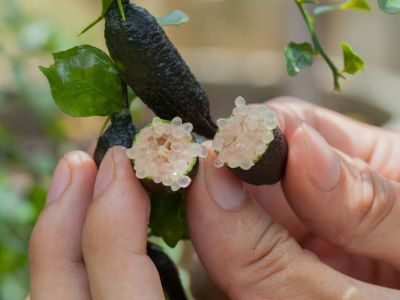What is an Australian Finger Lime?
Australian finger limes are found growing as an understory shrub or tree in the rainforests of SE Queensland and Northern NSW, areas of the Bundjalung nation. In nature the plant reaches a height of about 20 feet (6 m.). Like many other citrus varieties, trees are thorny and also like other citrus, Australian finger lime contains aromatic oil glands. They bloom in the fall with white to light pink blossoms that give way to finger shaped fruit that is about five inches (12 cm.) long. In the wild the tree is quite diverse with both fruit and trees varying in shape, size, color, and seeds. Generally, fruit has green to yellow skin and pulp but color variations from almost black to yellow to magenta and pink occur. Regardless of the color, all finger limes have pulp that resembles caviar and ripens between May and June. This caviar like fruit is also sometimes referred to as ‘pearls.’
Australian Finger Lime Info
The caviar-like pulp of the finger lime is comprised of separate juice vesicles that are compressed inside the fruit. The fruit has become quite popular due to its juicy, tangy flavor and unique look. There are five registered finger lime cultivars available which include ‘Alstonville,’ ‘Blunobia Pink Crystal,’ ‘Durhams Emerald,’ ‘Judy’s Everbearing,’ and ‘Pink Ice.’ Finger lime fruit does not ripen off the tree so pick it when it is fully ripe, when the fruit feels heavy and easily detaches from the limb of the tree.
How to Grow Australian Finger Limes
Australian finger lime grows on a wide array of soil types in both tropical and subtropical climates in dappled sunlight to full sun. In temperate regions finger limes should be grown in deep loamy soil with sufficient irrigation. The soil should be rich in organic matter and slightly acidic. Finger limes can withstand light frost but in cooler regions situate the tree facing north in a semi-shaded area. They can be grown directly in the garden or in containers. They also do well as a hedge or espalier. While Australian finger limes can be grown from seed, they will not grow true to the parent and seeds have a fairly low germination rate. Most trees are derived from grafted stock (Citrus trifoliate or Troyer citrange) which is hardier and matures more rapidly. Australian finger lime can also be grown using semi-hardwood cuttings although they will grow slowly, and the success rate is nominal. Use a growth hormone to stimulate root cuttings.
Australian Finger Lime Care
Mulch around finger lime trees to keep the soil moist during the summer months. During the winter, protect the tree from frost and drying winds. Although the tree can grow fairly tall, regular pruning can delay its size. Fertilize lightly with a water soluble fertilizer every three months or more often with worm castings or seaweed emulsion. Australian finger limes are susceptible to aphids, caterpillars, grasshoppers, and the fungal disease Melanose.
